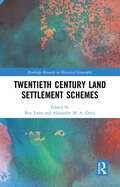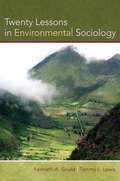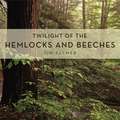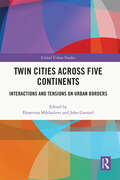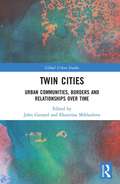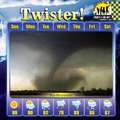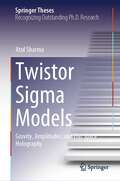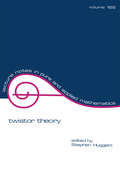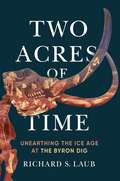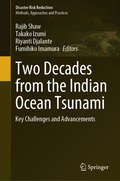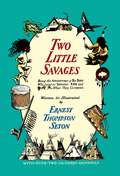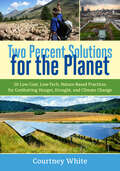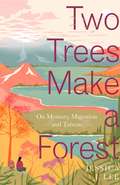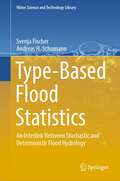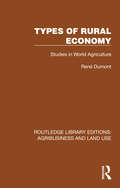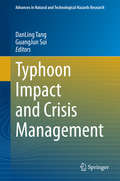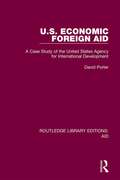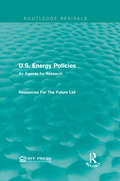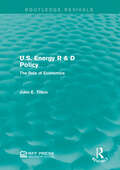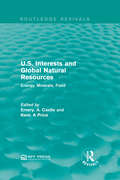- Table View
- List View
Twentieth Century Land Settlement Schemes (Routledge Research in Historical Geography)
by Roy Jones Alexandre M.A. DinizLand settlement schemes, sponsored by national governments and businesses, such as the Ford Corporation and the Hudson’s Bay Company, took place in locations as diverse as the Canadian Prairies, the Dutch polders, and the Amazonian rainforests. This novel contribution evaluates a diverse range of these initiatives. By 1900, any land that remained available for agricultural settlement was often far from the settlers’ homes and located in challenging physical environments. Over the course of the twentieth century, governments, corporations and frequently desperate individuals sought out new places to settle across the globe from Alberta to Papua New Guinea. This book offers vivid reports of the difficulties faced by many of these settlers, including the experiences of East European Jewish refugees, New Zealand soldier settlers and urban families from Yorkshire. This book considers how and why these settlement schemes succeeded, found other pathways to sustainability or succumbed to failure and even oblivion. In doing so, the book indicates pathways for the achievement of more economically, socially and environmentally sustainable forms of human settlement in marginal areas. This engaging collection will be of interest to individuals in the fields of historical geography, environmental history and development studies.
Twenty Lessons in Environmental Sociology
by Tammy L. Lewis Kenneth A. GouldThe most student-oriented book available for environmental sociology courses, Twenty Lessons in Environmental Sociology introduces undergraduates to the subject in a groundbreaking new way. Instead of compiling articles from professional journals, this innovative reader presents twenty classroom-tested "lessons" from dedicated, experienced teachers. These diverse readings examine key topics in the field, from the social construction of nature to the growing influence of global media on our understanding of the environment. Building this collection on the model of a successful undergraduate classroom experience, coeditors Kenneth A. Gould and Tammy L. Lewis asked the contributors to choose a topic, match it with their favorite class lecture, and construct a lesson to reflect the way they teach it in the classroom. The result is an engaging, innovative, and versatile volume that presents the core ideas of environmental sociology in concise, accessible chapters. Each brief lesson is designed as a stand-alone piece and can be easily adapted into an existing course syllabus. Ideal for any course that looks at the environment from a sociological perspective, Twenty Lessons in Environmental Sociology offers an insightful introduction to this dynamic subject.
Twilight of the Hemlocks and Beeches (Keystone Books)
by Tim PalmerIn this magnificently illustrated book, conservationist and celebrated outdoors photographer Tim Palmer launches us on a revealing journey among the hemlock and beech trees that have for millennia towered over America’s eastern woodlands. The eastern hemlock and North American beech once thrived from Maine to Georgia, casting shade on trout streams, nourishing wildlife large and small, and gracing uncounted valleys, mountainsides, parks, and backyards. These trees now face tragic decimation by exotic insects and pathogens. Palmer’s photos record the splendor of the cherished hemlock and beech in the same way that pictures of iconic, historic buildings commemorate classic landmarks gone the way of the wrecking ball. And yet, as Palmer underscores in his final chapter, the lessons learned as we address the fate of these trees can help us chart a better course for all wooded landscapes in the years ahead. This story of loss, scientific inquiry, and prospective recovery is vital to understanding nature in our time.As an act of artistic preservation, a report on the science vital to the survival of these trees, and a call to action, Twilight of the Hemlocks and Beeches assures a lasting legacy for this irreplaceable forest community. With more than one hundred exquisite full-color photographs, this book is a must-have for outdoor enthusiasts, natural historians, ecologists, and all lovers of nature.
Twilight of the Hemlocks and Beeches (Keystone Books)
by Tim PalmerIn this magnificently illustrated book, conservationist and celebrated outdoors photographer Tim Palmer launches us on a revealing journey among the hemlock and beech trees that have for millennia towered over America’s eastern woodlands. The eastern hemlock and North American beech once thrived from Maine to Georgia, casting shade on trout streams, nourishing wildlife large and small, and gracing uncounted valleys, mountainsides, parks, and backyards. These trees now face tragic decimation by exotic insects and pathogens. Palmer’s photos record the splendor of the cherished hemlock and beech in the same way that pictures of iconic, historic buildings commemorate classic landmarks gone the way of the wrecking ball. And yet, as Palmer underscores in his final chapter, the lessons learned as we address the fate of these trees can help us chart a better course for all wooded landscapes in the years ahead. This story of loss, scientific inquiry, and prospective recovery is vital to understanding nature in our time.As an act of artistic preservation, a report on the science vital to the survival of these trees, and a call to action, Twilight of the Hemlocks and Beeches assures a lasting legacy for this irreplaceable forest community. With more than one hundred exquisite full-color photographs, this book is a must-have for outdoor enthusiasts, natural historians, ecologists, and all lovers of nature.
Twilight of the Machines
by John ZerzanThe mentor of the green anarchist and neo-primitive movements is back with his first book in six years, confronting civilisation, mass society, modernity and technoculture - both the history of its developing crisis and the possibilities for its human and humane solutions. As John Zerzan writes, 'These dire times may yet reveal invigorating new vistas of thought and action. When everything is at stake, all must be confronted and superseded. At this moment, there is the distinct possibility of doing just that. '
Twin Cities across Five Continents: Interactions and Tensions on Urban Borders (Global Urban Studies)
by Mikhailova Ekaterina Garrard JohnThis international collection provides a comprehensive overview of twin cities in different circumstances – from the emergent to the recently amalgamated, on 'soft' and 'hard' borders, with post-colonial heritage, in post-conflict environments and under strain. With examples from Europe, the Middle East, Africa, Asia, South America, North America and the Caribbean, the volume sees twin cities as intense thermometers for developments in the wider urban world globally. It offers interdisciplinary perspectives that bridge history, politics, culture, economy, geography and other fields, applying these lenses to examples of twin cities in remote places. Providing a comparative approach and drawing on a range of methodologies, the book explores where and how twin cities arise; what twin cities can tell us about international borders; and the way in which some twin cities bear the spatial marks of their colonial past. The chapters explore the impact on twin-city relations of contemporary pressures, such as mass migration, the rise of populism, East-West tensions, international crime, surveillance, rebordering trends and epidemiological risks triggered by the COVID-19 pandemic. With case studies across the continents, this volume for the first time extends twin-city debates to fictional imaginings of twin cities. Twin Cities across Five Continents is a valuable resource for researchers in the fields of anthropology, history, geography, urban studies, border studies, international relations and global development as well as for students in these disciplines.
Twin Cities: Urban Communities, Borders and Relationships over Time (Global Urban Studies)
by John Garrard Ekaterina MikhailovaThis dynamic international collection provides a comprehensive overview of twin cities on administrative and international borders across the world. Drawing on contemporary and historical examples, it documents constant and changing features of twinned communities over time. The chapters explore a variety of urban formations including independent cities located side-by-side; cities that have merged over decades or even centuries and those projected to merge; cities partitioned by treaties and cities duplicated in pursuit of better security, intensified trade or both between neighbouring countries. From Europe to Africa, North America to the Middle East, South America to Asia, this book focuses on relationships between cities, citizens and municipal/international borders. A cartographical contents and editorial commentary guide readers through diverse contributions. The authors ask how far cities are changing or remaining constant in the context of conurbanisation, Europeanisation and globalization. The book provides a glimpse into the variety of roles twin cities can play globally: from laboratories of integration and para-diplomatic actors to economic and cultural brokers. This is a valuable, engaging resource for researchers in the fields of geography, urban studies, border studies, international relations and global development. It will be of great use to individuals involved in twin-city initiatives and general readers.
Twister!
by Kris HirschmannDoes that green sky mean a tornado is on its way? Are you wondering What's It Like Out?In this exciting book discover how funnel clouds become tornadoes. Find out how forecasters predict what's coming next. Learn all about the science of weather so you can answer the question, What's It Like Out?
Twistor Sigma Models: Gravity, Amplitudes, and Flat Space Holography (Springer Theses)
by Atul SharmaIn recent decades, twistor theory has grown into an irreplaceable tool for the study of scattering amplitudes in gauge theory and gravity. This book introduces the reader to cutting-edge advances in twistor theory and its applications to general relativity. The problem of graviton scattering in four dimensions is shown to be dual to dramatically simpler computations in a two-dimensional CFT known as a twistor sigma model. Twistor sigma models are the first step toward a holographic description of gravity in asymptotically flat space-times. They underpin the infinitely many asymptotic symmetries of flat space physics discovered in celestial holography, and extend them to exciting new arenas like curved space-times. They also yield intrinsically mathematical results in the field of hyperkähler manifolds. This volume will be of broad interest to students and researchers looking for an accessible entry point into twistor geometry, scattering amplitudes, and celestial holography. It will also provide an invaluable reference for specialists by bringing together results from a host of different disciplines.
Twistor Theory
by AuthorPresents the proceedings of the recently held conference at the University of Plymouth. Papers describe recent work by leading researchers in twistor theory and cover a wide range of subjects, including conformal invariants, integral transforms, Einstein equations, anti-self-dual Riemannian 4-manifolds, deformation theory, 4-dimensional conformal structures, and more.;The book is intended for complex geometers and analysts, theoretical physicists, and graduate students in complex analysis, complex differential geometry, and mathematical physics.
Two Acres of Time: Unearthing the Ice Age at the Byron Dig
by Richard S. LaubIn 1959, what appeared to be the bones of a mastodon were found in a western New York pasture. When researchers began to investigate further in the early 1980s, the site proved to hold far more. Known as the Hiscock Site, it contained an astonishingly rich trove of fossils and artifacts dating from the late Ice Age through the onset of European settlement. For nearly three decades, work at the site—the “Byron Dig”—unearthed new evidence of changing fauna, flora, cultures, and environments over the past 13,000 years.In Two Acres of Time, Richard S. Laub—the principal investigator of the project—tells the story of the Byron Dig. Recounting twenty-nine years of intensive excavation involving more than a thousand participants, he provides a comprehensive account of a working paleontological and archaeological field project and its contributions to our knowledge of the past. Laub explores how understanding of the site evolved through the years, the surprises that came to light along the way, and how contributions from numerous researchers helped achieve a fuller picture of the significance of the findings. The book also shows how people from all walks of life—not only scientists but also volunteers and local small-town residents—worked together to unearth and interpret the site’s contents and to preserve them for future generations. This extensively illustrated book connects life at a scientific excavation project to the grand sweep of long-ago epochs, and is a compelling read and resource for researchers and general readers alike.
Two Decades from the Indian Ocean Tsunami: Key Challenges and Advancements (Disaster Risk Reduction)
by Rajib Shaw Takako Izumi Riyanti Djalante Fumihiko ImamuraThis book presents the advancements in the disaster risk reduction and resilience building in the countries affected by the Indian Ocean Tsunami countries. The book includes a few cross-cutting issues related to governance, technology, and communities, with two major parts: (1) cross-cutting issues and (2) regional and country level experiences. At the threshold of twenty years from Indian Ocean Tsunami, the concept of disaster risk reduction field has evolved significantly in the affected countries as well as around the world. Globally, several mega disasters happened in the last 20 years, and risk landscape has become more complex. In addition, technology, governance, and people’s resilience have gained positive momentum. We had two world conferences on disaster risk reduction, resulting in two global disaster risk reduction frameworks, which aligned with development frameworks as well as climate change agreements. COVID-19 and post COVID risk landscape has brought the new dimension of compound and complex disasters and need for all hazards’ approach.
Two Little Savages: Being the Adventures of Two Boys Who Lived as Indians and What They Learned
by Ernest Thompson SetonThis is one of the great classics of nature and boyhood by one of America's foremost nature experts. It presents a vast range of woodlore in the most palatable of forms, a genuinely delightful story. It will provide many hours of good reading for any child who likes the out-of-doors, and will teach him or her many interesting facts of nature, as well as a number of practical skills. It will be sure to awaken an interest in the outdoor world in any youngster who has not yet discovered the fascination of nature.The story concerns two farm boys who build a teepee in the woods and persuade the grownups to let them live in it for a month. During that time they learn to prepare their own food, build a fire without matches, use an axe expertly, make a bed out of boughs; they learn how to "smudge" mosquitoes, how to get clear water from a muddy pond, how to build a dam, how to know the stars, how to find their way when they get lost; how to tell the direction of the wind, blaze a trail, distinguish animal tracks, protect themselves from wild animals; how to use Indian signals, make moccasins, bows and arrows, Indian drums and war bonnets; how to know the trees and plants, and how to make dyes from plants and herbs. They learn all about the habits of various birds and animals, how they get their food, who their enemies are and how they protect themselves from them.Most of this information is not generally available in books, and could be gained otherwise only by years of life and experience in suitable surroundings. Yet Mr. Thompson Seton explains it so vividly and fully, with so many clear, marginal illustrations through the book, that the reader will finish "Two Little Savages" with an enviable knowledge of trees, plants, wild-life, woodlore, Indian crafts and arts, and survival information for the wilds. All of this is presented through a lively narrative that has as its heroes two real boys, typically curious about everything in the world around them, eager to outdo each other in every kind of endeavor. The exciting adventures that befall them during their stay in the woods are just the sort of thing that will keep a young reader enthralled and will stimulate his or her imagination at every turn.
Two Percent Solutions for the Planet: 50 Low-Cost, Low-Tech, Nature-Based Practices for Combatting Hunger, Drought, and Climate Change
by Courtney WhiteTwo Percent Solutions for the Planet profiles fifty innovative practices that soak up carbon dioxide in soils, reduce energy use, sustainably intensify food production, and increase water quality. The &“two percent&” refers to: the amount of new carbon in the soil needed to reap a wide variety of ecological and economic benefits; the percentage of the nation&’s population who are farmers and ranchers; and the low financial cost (in terms of GDP) needed to get this work done.As White explained in Grass, Soil, Hope, a highly efficient carbon cycle captures, stores, releases, and recaptures biochemical energy, mitigating climate change, increasing water storage capacities in soil, and making green plants grow. Best of all, we don&’t have to invent anything new—a wide variety of innovative ideas and methods that put carbon back into the soil have been field-tested and proven to be practical and profitable. They&’re mostly low-tech, too, relying on natural resources such as sunlight, green plants, animals, compost, beavers, creeks, and more.In Two Percent Solutions for the Planet, White expands what he calls the &“regenerative toolbox,&” to include holistic grazing, edible forests, biochar, weed-eating livestock, food co-ops, keyline plowing, restoration agriculture, bioenergy, aquaponics, animal power, Farm Hack, bees, bears, wildlife corridors, rainwater harvesting, native seeds, and various other projects from across the United States, as well as in Canada, Europe, and Australia. These short, engaging success stories will help readers connect the dots between diverse, exciting, and pragmatic practices, and inspire them to dig deeper into each individual story and concept, energized by the news that solutions do exist.
Two Trees Make a Forest: On Memory, Migration and Taiwan
by Jessica J. LeeI have learned many words for 'island': isle, atoll, eyot, islet, or skerry. They exist in archipelagos or alone, and always, by definition, I have understood them by their relation to water. But the Chinese word for island knows nothing of water. For a civilisation grown inland from the sea, the vastness of mountains was a better analogue: (dao, 'island') built from the relationship between earth and sky.Between tectonic plates and conflicting cultures, Taiwan is an island of extremes: high mountains, exposed flatlands, thick forests. After unearthing a hidden memoir of her grandfather's life, written on the cusp of his total memory loss, Jessica J Lee hunts his story, in parallel with exploring Taiwan, hoping to understand the quakes that brought her family from China, to Taiwan and Canada, and the ways in which our human stories are interlaced with geographical forces. Part-nature writing, part-biography, Two Trees Make a Forest traces the natural and human stories that shaped an island and a family.
Tying Flood Insurance to Flood Risk for Low-Lying Structures in the Floodplain
by Committee on Risk-Based Methods for Insurance Premiums of Negatively Elevated Structures in the National Flood Insurance ProgramFloods take a heavy toll on society, costing lives, damaging buildings and property, disrupting livelihoods, and sometimes necessitating federal disaster relief, which has risen to record levels in recent years. The National Flood Insurance Program (NFIP) was created in 1968 to reduce the flood risk to individuals and their reliance on federal disaster relief by making federal flood insurance available to residents and businesses if their community adopted floodplain management ordinances and minimum standards for new construction in flood prone areas. Insurance rates for structures built after a flood plain map was adopted by the community were intended to reflect the actual risk of flooding, taking into account the likelihood of inundation, the elevation of the structure, and the relationship of inundation to damage to the structure. Today, rates are subsidized for one-fifth of the NFIP's 5. 5 million policies. Most of these structures are negatively elevated, that is, the elevation of the lowest floor is lower than the NFIP construction standard. Compared to structures built above the base flood elevation, negatively elevated structures are more likely to incur a loss because they are inundated more frequently, and the depths and durations of inundation are greater. Tying Flood Insurance to Flood Risk for Low-Lying Structures in the Floodplain studies the pricing of negatively elevated structures in the NFIP. This report review current NFIP methods for calculating risk-based premiums for these structures, including risk analysis, flood maps, and engineering data. The report then evaluates alternative approaches for calculating risk-based premiums and discusses engineering hydrologic and property assessment data needs to implement full risk-based premiums. The findings and conclusions of this report will help to improve the accuracy and precision of loss estimates for negatively elevated structures, which in turn will increase the credibility, fairness, and transparency of premiums for policyholders.
Type-Based Flood Statistics: An Interlink Between Stochastic and Deterministic Flood Hydrology (Water Science and Technology Library #124)
by Andreas H. Schumann Svenja FischerThis book summarises for the first time all relevant methodologies for type-based flood statistics, introduces the basis of flood typology and makes them accessible to the user. Flood types improve the understanding of the flood-generating processes and characterise the flood event in terms of its features such as peak, volume and hydrograph shape. In addition, they can also significantly expand the information used in flood statistics and add valuable flood characteristics to the determination of design floods, especially the determination of flood scenarios relevant for reservoir management. A detailed framework with all aspects of point and spatial statistics as well as regionalisation is presented, and examples illustrate the benefit of the proposed methodology. The target audience is both users in associations and engineering offices, as type-based statistics are increasingly becoming part of the specifications, and researchers, as this is a current field of research.
Types of Rural Economy: Studies in World Agriculture (Routledge Library Editions: Agribusiness and Land Use #8)
by René DumontOriginally published in English in 1957 this book quickly became a classic of comparative agricultural studies. The book brings together a wide range of case studies from the UK, Europe, Africa and South East Asia which together form a broad yet highly detailed view of world agriculture in the 20th Century.
Typhoon Impact and Crisis Management
by Dan Ling Tang Guangjun SuiMajor natural hazards have sparked growing public concern worldwide. This book provides new information on Typhoon Impact and Crisis Management using satellite remote sensing technology, linking the natural sciences and social sciences in typhoon studies. It examines remote sensing observations of typhoons (hurricanes), typhoon impacts on the environment, typhoon impacts on marine ecosystems, typhoon impacts and global changes, typhoon (hurricane) impacts on economics, and crisis management for typhoon (hurricane) disasters.
U. S. Landforms
by Dana Meachen RauGet ready to take an exciting cross-country trip across the United States--from the big cities of the Northeast to the deserts of the Southwest. Engaging text and thrilling images introduce you to the unique geography, history, and culture of our country's various regions.
U.S. Economic Foreign Aid: A Case Study of the United States Agency for International Development
by David PorterOriginally published in 1990, this volume is a comprehensive study of United States foreign aid allocation from 1961-1983 and the significance it has for US Foreign Policy as a whole. As well as developing a theoretically consistent measure of poverty for the research, the book also examines the relationship between bilateral foreign aid and multilateral foreign aid. A number of theoretical issues in comparative politics, international relations, US domestic institutional decision making and the development of political and economic institutions are explored.
U.S. Energy Policies: An Agenda for Research (Routledge Revivals)
by Resources For The Future LtdU.S. Energy Policies, first published in 1968, aims to assemble and describe within an overall framework the energy policy questions that RRF believed would profit from study and analysis. This study covers the past performance and trends in the energy industries, the nature of existing industries and of the government policies bearing on them, and the effects of those policies. This title also takes note of the prospective influence of economic and technological developments and evaluates the probable effects of selected alternatives to existing policies. This book will be of interest to students of environmental studies.
U.S. Energy R & D Policy: The Role of Economics (Routledge Revivals)
by John E. TiltonDuring the past few decades there has been an advance in the research and development of solving the issue of declining energy resources. Funding by the U.S. government into energy research has risen steeply. Because of the growing importance of research and development in this field of research, in 1973 Resources for the Future undertook a study of energy-associated study, including an investigation of how research on energy R & D itself could be carried out. This title, first published in 1974, assesses a wide range of ways in which economics could contribute to decisions on where and in what amounts government R & D money should be spent. The report also evaluates the research and development approach in relation to other public energy policies or management tools. The book will be of interest to students of environmental studies and economics.
U.S. Interests and Global Natural Resources: Energy, Minerals, Food (Routledge Revivals)
by Kent A. Price Emery N. CastleOriginally published in 1983, U.S. Interests and Global Natural Resources explores the links between foreign policy and the global distribution of natural resources paying particular attention to the U.S. This collection of essays delves into the importance of factors such as differing economic development and political hostility could have on the provision of resources into the U.S and advises that nations identify their countries needs and establish policies to safeguard them. This title will be of interest to students of Environmental Studies and Policy makers.
